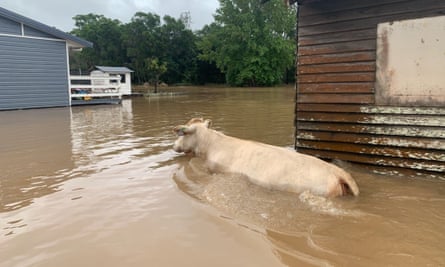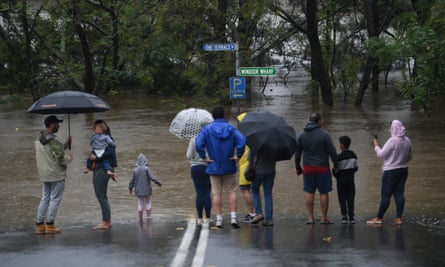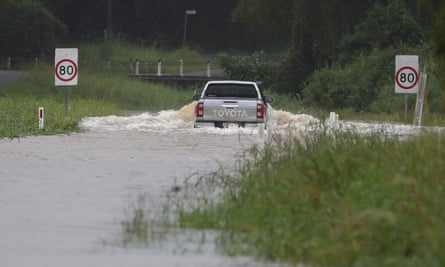Some 10 million Australians remain under a weather warning on Monday night as a group of colliding weather systems cause flooding chaos across swathes of New South Wales, leading to dozens of communities being declared disaster zones and forcing more than 18,000 people to evacuate from their homes.
More than 800mm of rain has fallen in less than a week in some parts of the Australian state, leaving a trail of destruction which stretched from the densely populated suburbs of western Sydney to the sleepy coastal towns of Taree and Kempsey, hundreds of kilometres away on the NSW mid-north coast.
As night fell on Monday, authorities in the state issued a flurry of new flood and evacuation warnings, as rivers west of Sydney rose faster than expected, emphasising the danger had far from passed.
The NSW premier, Gladys Berejiklian, described it as a “miracle” that no lives had been lost, but with another 50-100mm expected to fall across pasts of the east coast again on Tuesday, and river levels still rising, thousands of Australians remained on high-alert.
The extent of the deluge shocked experts. Justin Robinson, a flooding forecaster for the Bureau of Meteorology, Australia’s weather agency, said it was the “worst flooding that I have experienced and I have had to forecast” in 20 years in the job. Berejiklian said the floods were “an event which far exceeds what has occurred in the past 50 or 60 years”.
The floods come less than 18 months after Australia was gripped by a bushfire crisis which saw towns levelled and dozens killed. Many of the places which have found themselves inundated by a record downfall were still recovering from that disaster.
“Some communities battered by the bushfires are now being battered by the floods, and deep drought prior to that,” Berejiklian said on Monday.
“I don’t know any time in the state’s history where we have had these extreme weather conditions in such quick succession [and] in the middle of a pandemic.”

In the town of Windsor, which sits on the banks of the Hawkesbury River on Sydney’s north-west fringe, volunteers filled sandbags for nervous residents hoping to protect their homes.
One of them, Alistair Dent, a Windsor local, said the men – who were mostly members of a local church – had stayed up throughout the night on Sunday and into Monday morning handing out some 150 tonnes of sand.
“I had a lady crying on my shoulder yesterday afternoon. I think people are quite worried,” he said.
In nearby Pitt Town, Aaron Schultz pointed out the places where his shed, stables and water tank used to be, while he prepared his property before evacuating. All of it had been submerged by Monday afternoon, and the speed at which the water rose during the day had convinced him he needed to leave.
He still did not know where he would be staying on Monday night, after the friend he had hoped to stay with was also forced to evacuate. “Somewhere far away from here,” he said.

The bulk of the flooding had taken place in two parts of the state – both the outer western suburbs of Sydney and the regional mid-north coastal areas around Taree and Kempsey.
Berejiklian on Monday told reporters that some 15,000 mid-north coast residents had been evacuated, along with around 3,000 residents from western Sydney’s Nepean-Hawkesbury region.
Quick GuideIs NSW flooding yet more evidence of climate change?
Show
Experts say it’s unusual to see so many places with such high rainfall across such a wide area.
The extreme rainfall came after three weather systems combined, and fell on already saturated ground due to a wetter-than-average summer, thanks in part to the La Nina weather pattern.
A warmer atmosphere can hold more moisture - about 7% for each degree of warming - so there's more available to fall as rain. If you do the maths, Australia has warmed by 1.4C, accounting for roughly 5-10% of the rain.
But climate scientists say it's not that simple because of the many different factors that influence rainfall. Climate change could also be making weather patterns that deliver downpours more frequent, but again, more research is needed.
“I am so relieved [that] until this point in time no one has lost their lives, which is a miracle given what we have been through, and we really want to maintain that,” the premier said.
The NSW State Emergency Service had received some 8,000 calls for help by the mid-afternoon, including an elderly woman with a broken hip in the town of Kempsey. In the north coast town of Telegraph Point, Megan Nourse said a flash downpour had flooded her home in 10 minutes, forcing her to swim through her own living room trying to find her son and daughter.
“We had to swim under the door frame. My son got the canoe out … we swam out there and he canoed us out, and then he was canoeing back to our top-story lounge room and windows to get our dogs out,” she said.
Still, some had remained optimistic. Kate Fotheringham, from the state’s mid-north coast, was almost forced to delay her wedding after the venue was flooded. Instead, she was helicoptered into the site and posted a photo on social media with her new husband surrounded by floodwaters.
Update, I made it to the church and married the love of my life! Affinity Helicopters in Port Macquarie came to the rescue and made sure we all got there. This is the bridge that blocked us from making the 5minute drive into town! What a day! #fotherbellwedding #floodwingham pic.twitter.com/u7OlsFsTjQ
— Kate Fotheringham (@KatelFog) March 22, 2021
By Monday afternoon, evacuation orders had been issued for large chunks of western Sydney, though earlier warnings for major townships such as Penrith had been revoked. Flooding had occurred after Warragamba Dam, Sydney’s main water supply, spilled over on Sunday afternoon.
The mayor of Penrith, Karen McKeown, told the ABC that parts of the river appeared to have peaked at 10 metres and were receding, but warned that there were “still some scary times ahead”.

“Unfortunately, those waters are now flowing down towards Richmond and Windsor,” she said.
“I would urge residents as well, even though the river is maybe receding at the moment, all those drainage areas, storm rivulets, all those infrastructures surrounding the suburbs are doing their job … do not drive through any water at all. You may not know the depth.”
On the mid-north coast, where communities were facing the worst flooding conditions since 1929, evacuation orders were in place for dozens of communities, with some areas receiving more than 800mm of rain since Thursday.
Some 10 million Australians were under a severe weather warning on Monday night – including major cities along the east coast such as Wollongong, Sydney, Newcastle and Grafton, as well as the north-west of the state in areas such as Cobar, Dubbo and Moree.
Much of the wild weather had been caused by the combination of three separate weather systems: a tropical low off the Kimberley coast of Western Australia, a coastal trough sitting off the NSW coast, and an area of stationary high pressure between Tasmania and New Zealand that had been pushing winds to the NSW coast for more than a week.

Those weather systems have also been felt outside of NSW. Parts of Queensland saw heavy rain and flash flooding over the weekend with Brisbane and the Gold Coast the hardest hit.
Mount Tamborine recorded more than 250mm in 24 hours, while the state’s capital, Brisbane, received over 100mm in the same period.
Despite this, Queensland’s premier, Annastacia Palaszczuk, announced on Sunday that specialist crews from Queensland Fire and Emergency Services were being sent to NSW to help deal with the unfolding disaster down south.
Jonathan How, a forecaster with the Bureau of Meteorology, told the Guardian that heavy rain was also expected to soon hit the Victorian capital of Melbourne. A severe weather warning could also be issued for eastern Tasmania on Tuesday morning.
While the rain was expected to ease in NSW on Wednesday, How warned it could be some time before the flood waters subsided.
“Water on the ground moves much more slowly than water in the air. Rainfall can come in a few hours, but the effects of floods can stay for days,” he said.
How also warned the expected heavy fall on Tuesday could see things worsen again. “If you get 100mm [around Sydney and the NSW north coast], you could get a peak in the rivers around Hawkesbury and Nepean tomorrow,” he said on Monday.
Climate Council spokesperson Prof Will Steffan said intense rainfall and floods were happening more frequently due to climate change.
“Climate change is harming the health, safety and livelihoods of Australians, raking up billions of dollars in economic losses and damaging many of our unique ecosystems. It’s time for all levels of government and businesses to step up their climate action efforts to protect people, our environment and the economy,” he said.
“We must take decisive action this decade to bring climate change under control. Australia must get to net zero emissions well before 2040, and accelerate efforts to shift away from coal and gas to a fully renewables-powered economy.”